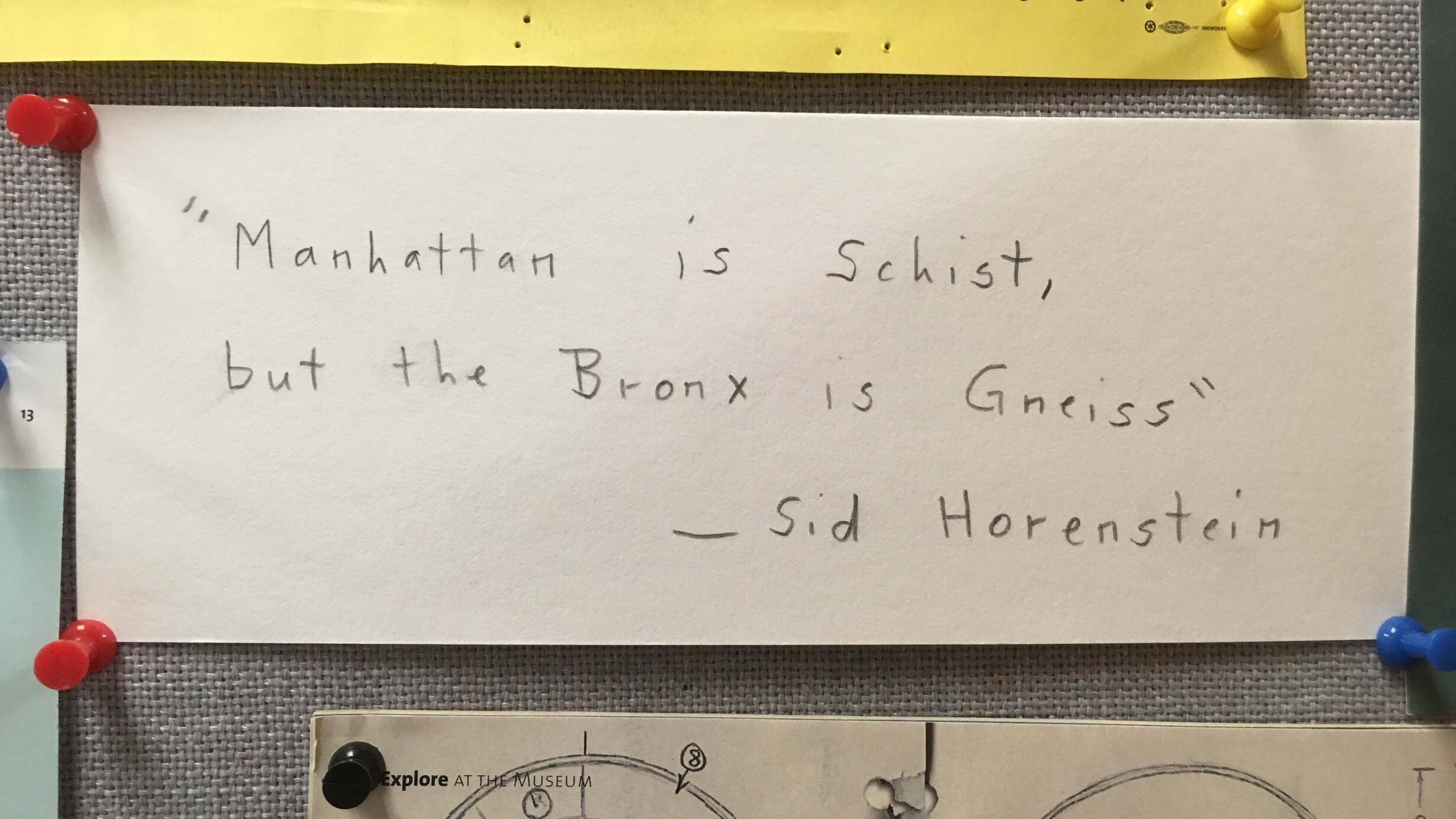 A quote by Sidney Horenstein posted in the Library's office space, which reads, "Manhattan is schist, but the Bronx is gneiss."
A quote by Sidney Horenstein posted in the Library's office space, which reads, "Manhattan is schist, but the Bronx is gneiss."Cwiok, Jennifer (photographer)
Most importantly, I ensure that the history of a collection or object is captured and described in a way that lets researchers identify it and understand its relationship to the Museum’s history. This is some of the most meaningful and impactful work that I do as an archivist. We are always working to make the materials and these relationships discoverable in the Archives and Authorities databases. The migration of this information to remotely-accessible databases is made all the more important with the access challenges caused by the COVID-19 pandemic.
Where there are challenges there are also opportunities. The pandemic has provided a welcome window to work with Kendra Meyer, Shelby White & Leon Levy Digital Archivist to consider these accessioning steps as they relate to digital assets that are part of the archives. Digital assets often come in as part of larger paper collections. Among the projects waiting for me at the Museum is my work with one of these hybrid collections.
Rota, Alex J. (photographer)
Sidney Horenstein Collection
Late in 2018 one of the AMNH Library’s favorite scientific colleagues passed away. Sidney Horenstein was a good friend to many of us in the Research Library. Sid was a geologist and frequent lecturer on topics related to the geology of New York, including the identities and origins of the building materials brought in to build the city’s structures. His work in the Museum began in 1964, and he retired as Environmental Educator Emeritus in 2004 and remained active at the Museum through 2018.
Sid always had a compelling research project that he was pursuing which often included some sort of interesting Museum history. He had a way of sharing his newest investigation that revealed his skills as an educator and storyteller, drawing in the librarian and archivist in to partner on his quest for information.
One of the last research projects that Sid worked on was an effort to document the history of an early, large plaster relief map of Manhattan that was recently brought to the Library from another part of the Museum and hung in the work area where I spend a lot of time. Sid was thrilled when he first saw the map in our processing area and remarked, “Oh it still exists!” Sid said that it originally hung in one of the very early Museum geology halls and was created by a man who became very well known in his field. It documents early estuaries and wetlands in Manhattan that have since been reclaimed with landfill or built over. Unfortunately for us and the map we don’t know if Sid finished this project as I have yet to locate his working manuscript on the map.
Rhodes, Barbara (photographer)
After Sid passed away I was given access to the mezzanine office space where he worked at the Museum to pack up the years of research materials that he had amassed and to begin to decide what among them should come to the Library Archives for access by future Museum staff and researchers. As I worked to pack up Sid’s Museum administrative, exhibit and research files for transfer to the Library, other interesting things that he collected over the years presented themselves. Illustrated old books about the history of New York City waterways including the Croton Aqueduct, accumulated reference files on building stones and the quarries that they came from and many, many maps of places he’d led tours or offered lectures.
Morgan, Rebecca (photographer)
I look forward to getting back to work Sid’s collection, as there is more that needs to be done to make sure that researchers will be able to find the useful data that his research files hold. Once the DAM is in place we will start to investigate the external hard drives that came with his papers as well, and if we’re lucky his manuscript for the curious map will be there.
References
Horenstein, S. New York City Mastodons: Big Apple Tusks. Evo Edu Outreach 1, 204–209 (2008).
This is the eleventh post in a series about how the Library's staff is working remotely and enriching its digital collections to enhance access to researchers and the public during the COVID-19 pandemic. This entry was written by Rebecca Morgan, Special Collections Archivist.